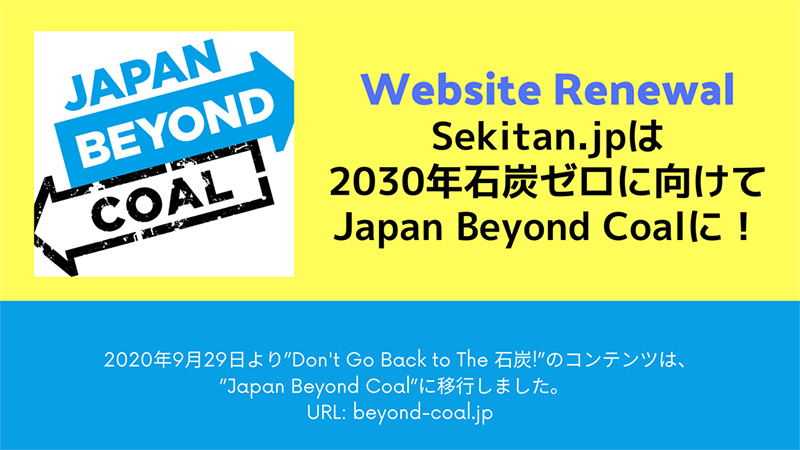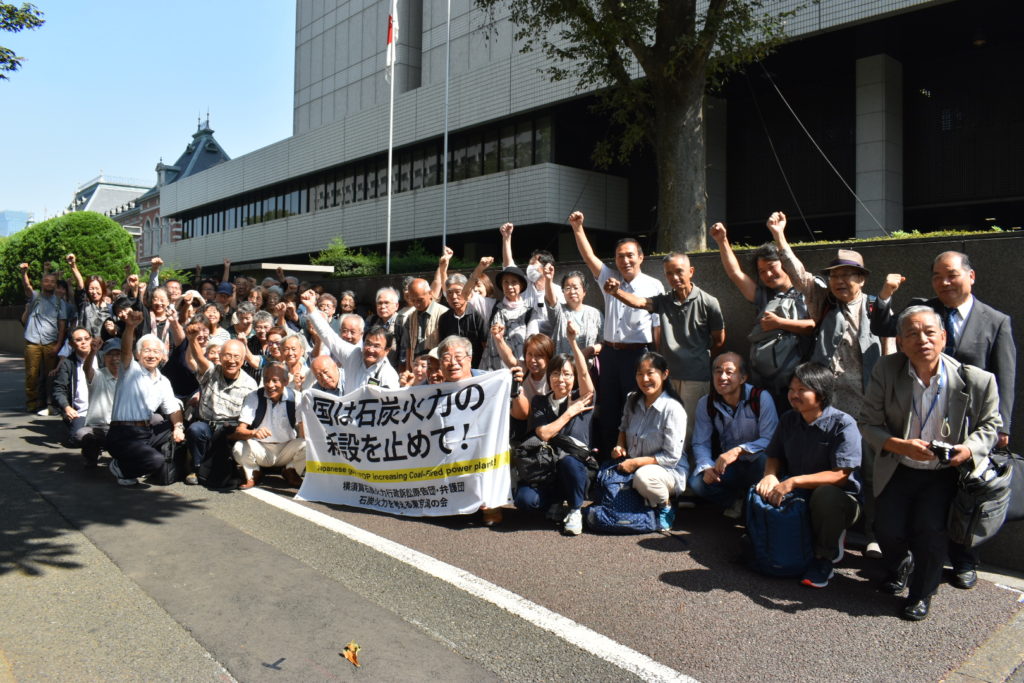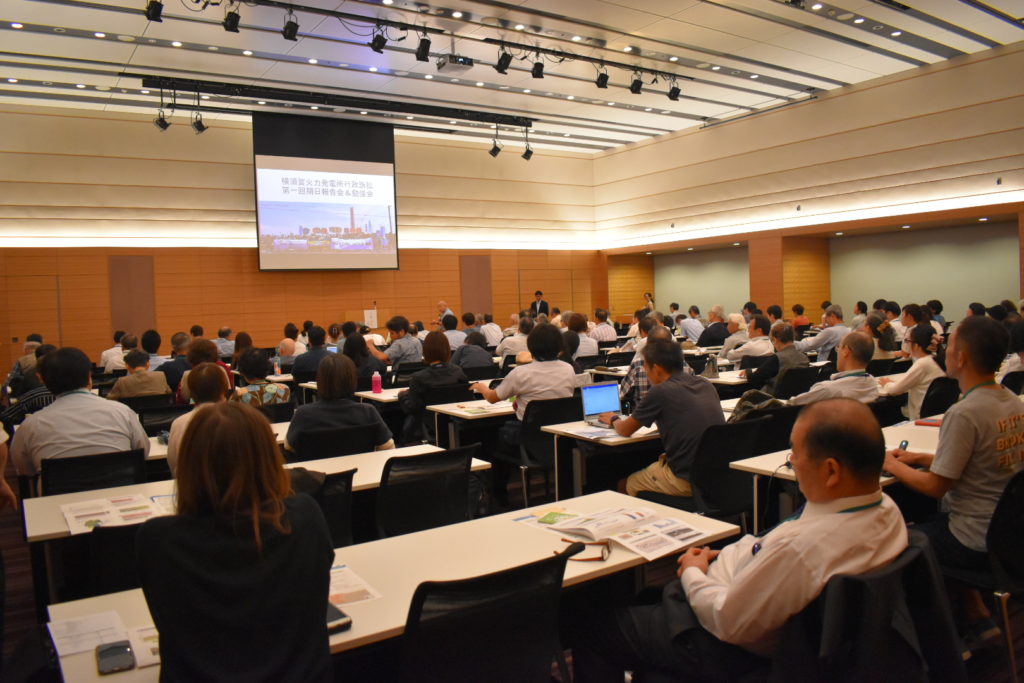[:ja]先月9月23日、国連事務総長の主催でニューヨークでの国連気候行動サミットが開催され、日本からは小泉新環境大臣が大臣初の外遊デビューを果たした。しかし、各国に対して温室効果ガス削減目標を引き上げや石炭火力発電所の脱却を強く求めていたグテーレス国連事務総長の要請に残念ながら日本は答えることができなかった。石炭火力を推進する立場の日本が世界から厳しい目にさらされていることは、小泉大臣はこのサミットを通じて身を持って感じたことだろう。
一方、小泉大臣の地元である横須賀において、株式会社JERAによる大規模石炭火力発電所建設計画が進み、住民たちが今年5月27日に国を提訴した裁判がようやく第一回目の期日を迎えた。横須賀火力発電所建設計画における環境アセスメントの手続きで確定通知を出した国(経済産業省)に対して、その取消を求める裁判である。国内外で気候変動問題や石炭火力に対しての注目が集まる中、10月2日の第一回期日には、大法廷の傍聴席を大幅に上回る120名の原告・サポーターが集まり、法廷の外に傍聴できない人があふれる事態となった。
裁判では、最初に鈴木陸郎原告団長から意見陳述が行われた。意見陳述は、甥御さんが公害認定患者となり、長い闘病生活の後に先立たれたという辛く悲しい思い出からはじまる。鈴木さんは、二度とこのような状況をつくってはいけないと心に誓った矢先に、地元横須賀での巨大な石炭火力発電所の建設計画を知り、環境アセスメントのプロセスをすべて追ってきた。旧火力発電所は長期停止に入って、徐々にきれいな大気を取り戻しつつある横須賀の空気をまた再び汚染し、喘息をはじめとする健康被害が懸念されると訴えた。また気候変動が深刻化する中で、大量の二酸化炭素を放出する石炭火力の建設など許されるはずがない、と主張し、「気候変動を緩和する日本の転換点となったと評価される歴史的な判断を下される」裁判になることを求めた。
次に、小島延夫弁護団長からの意見陳述が行われた。小島弁護士は、横須賀火力発電所建設計画の環境影響評価における問題を次の3つの論点で主張した。第一に、本来環境影響評価はベスト追求型でなければならないところ、本件ではベストを追求しているとは言い難いこと。つまり、最善の努力がされているかどうかを検討した、といえるためには、環境影響評価 においては、環境影響を回避するための措置、低減するための措置等について、具体的に複数案が検討されなければならない。さらに、環境アセスメントの手続きでは、市民の参加権を確保し、その意見を環境影響評価に検討・反映すべきことを義務づけているが、それも行われていない。事業者には、高度の説明責任が求められているが、それも不十分だった。
第二に、長期停止となっていた旧火力発電所と比較して、新規計画案件が「改善リプレース」だとして審査されたことは明らかに瑕疵であること。これは、温室効果ガスの排出量についても、2011年以降に旧火力が運転していた3、4号機の年間排出量は年間326万トン-CO2に対して、現在計画されている設備が年間726万トン-CO2と400万トンも上回ることから明らかだ。
第三に、この莫大なCO2排出をする石炭火力発電所の温室効果ガス対策に係る検討が不十分であり、本来であれば事業を実施しないという選択肢を含めて検討すべきであったが、事業者はそれをしていない。国はその点の是正を求めることが、環境保全への適正な配慮がなされることを確保するため特に必要であったと主張している。
被告(国)からは、この訴えに対して、①評価書確定通知は行政処分行為ではなく、取消訴訟の対象ではなく、取消訴訟提起は不適法であること、②原告適格(法律上保護された利益)を欠くことから速やかに却下されるべきとの18ページにわたる答弁書が提出されている。法廷では説明はなかった。
詳しくは、第一回期日の文書(こちら)を参照していただきたい。なお、第二回期日は2019年12月23日午後2時からとされた。長期にわたる闘いになり、その間にも工事が進んでいくことがもどかしい限りだ。
地元愛にあふれる小泉環境大臣は、地元での石炭火力発電所建設をめぐるこの訴訟をどうご覧になっているだろうか。日本の石炭火力発電所問題にどのように対処するか、国内外から注目される中、ぜひ大臣にはこの裁判の決着を待たずに、脱石炭に向けた動きをつくっていってほしいものだ。
[:en]The 2019 UN Climate Action Summit was held in New York on September 23, 2019. Representing Japan as Environment Minister, Shinjiro Koizumi, attended the summit on his first overseas trip since taking on the role earlier that month. However, he and the Japanese government failed to live up to the expectations of UN Secretary-General António Guterres, who had strongly requested attendees to raise their CO2 emission reduction targets and make the commitment to exit from coal-fired power generation. Having attended the Climate Summit, Minister Koizumi should now understand that Japan is under global scrutiny because of its pro-coal policy, which goes against the global trend of decarbonization.
Meanwhile, energy company JERA Co. is proceeding with construction of its proposed large-scale coal-fired power plant in Yokosuka City, Mr. Koizumi’s home town. On May 27, 2019, local residents and supporters filed a formal legal challenge against the Minister of Economy, Trade and Industry, seeking cancelation of the notice of finalization of the environmental impact assessment (EIA), which had paved the way for the construction of two new coal-fired generating units at the Yokosuka power plant. The first court date was on October 2. Amid mounting domestic and international concerns about climate change and coal power, more than 120 people gathered at the courthouse, including plaintiffs and supporters. The trial was held in a large courtroom at the Tokyo District Court, but observers spilled out of the room due to the lack of space.
One of the plaintiffs, Rikuro Suzuki, made a statement to the court. He spoke of his nephew, who had developed asthma, became an officially-certified patient with a pollution-related illness, and passed away a few years ago after suffering for years. Mr. Suzuki believed that no one should experience the loss of the younger generation dying as his nephew had from air pollution. As soon as he learned about the proposed Yokosuka coal power plant project, he had begun collecting information and following the entire EIA process. The former power plant on the same site had stopped operating years ago as part of a long term planned shutdown, and air quality had been gradually improving. But if built, the new coal-fired power plant operating here would again pollute the air, again resulting in asthma and other respiratory diseases in the community. He said it would be unacceptable to build any new plants that emit large amounts of CO2 and damage the environment. He closed by asking the court for “for a historical decision to be made in this trial that could become a turning point for climate change mitigation in Japan.”
After Mr. Suzuki, Attorney Nobuo Kojima, representing the legal team for the plaintiffs, emphasized three points in his statement.
1) Environmental impact assessments (EIA) must intrinsically pursue the best environmental outcomes, but in this case the proponent did not demonstrate best efforts to avoid and mitigate environmental impacts from this Yokosuka project. The proponent should also consider multiple concrete options. In addition, EIA assessment procedures require that the public is given the right to participate, and that public input is considered and reflected in the EIA process. But in this case, the proponent has failed to do all of the above. The proponent should also have a high level of accountability, but in this case it was inadequate.
2) The former coal-fired power plant on the Yokosuka site had not been operating for years as part of a long-term planned shutdown, so it was a serious flaw in the EIA process to label the new construction proposal as a “replacement” of existing equipment, and to compare the proposed new generating units with the older units. The older Units 3 and 4, which had been shut down for twenty years except for briefly being restarted after 2011, emitted previously 3.26 million tons of CO2 annually. The two new units if built will emit 7.26 million tons annually, an increase of at least 4.0 million tons per year.
3) The proponent gave inadequate consideration of measures to address the enormous CO2 emissions. EIA reviews should normally examine alternatives, including the option of not building the proposed plant, but the proponent did not examine this alternative. Mr. Kojima asserted that the Japanese government had a particular responsibility to ensure the proponent had done that as a part of proper consideration of environmental protection in this case.
The defendant (national government) submitted an 18-page pleadings in response to the case, but did not provide any oral statement to the court. The pleadings mentioned two points.
1) The notice of finalization of the EIA is not an administrative disposition, and not a target for legal action seeking its cancellation, so any action seeking its revocation has no legality.
2) The plaintiffs have no standing to initiate a legal action (i.e., they have no legally protected interests in the case), so the court should reject the case immediately.
Related documents on this first court date are available here (mostly in Japanese). The second court date is scheduled for December 23, 2019, starting at 14:00.
Meanwhile, it is disappointing that construction of the new generating units at the Yokosuka coal plant is continuing even while we wage this protracted legal battle.
Environment Minister Koizumi cherishes his home town, but we wonder how he views this lawsuit challenging the construction of a coal-fired power plant right there. He is being closely watched in Japan and internationally to see how he deals with the issue of coal in Japan, and we hope he will clear the path for Japan to decarbonize, without waiting for the conclusion of this lawsuit.



